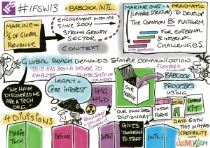This is one of a series of live blog posts directly from the site of the 2013 IFS World Conference in Barcelona. Business journalist Adam Tinworth is a veteran of Reed Business Information and a lecturer on digital journalism at City University in London. His first-hand impressions are accompanied by illustrations of Matthew Buck, cartoonist for Drawnalism.
Paul Bradley, Head of Application Solutions, Marine & Technology
 Babcock has grown through acquisition. It’s now a £1.2bn revenue company and a leading maritime support business, with a global spread. The Marine & Technology division is a growing business, and contributes more than a third of the group’s revenue. Submarines represent 31 percent of revenue on their own. Their largest customer is the UK MoD. They work closely with them, often using joint project teams, and they work on reducing whole-life costs.
Babcock has grown through acquisition. It’s now a £1.2bn revenue company and a leading maritime support business, with a global spread. The Marine & Technology division is a growing business, and contributes more than a third of the group’s revenue. Submarines represent 31 percent of revenue on their own. Their largest customer is the UK MoD. They work closely with them, often using joint project teams, and they work on reducing whole-life costs.
There are three key elements to the business:
- Through life engineering support
- Strategic facitliies
- Technology implementations
They do in-service support as part of through-life support. The infrastructure is unique – some assets are 400 years old, like bases at Rosyth and Devonport. Technology is “growing like topsy” – designing complex products for their customers.
The company grew out of Rosyth Royal Dockyards, as they were then known. IFS has been used since 2002. It was brought in to do specific jobs and replace legacy systems like SAP. Step by step, module by module, they’ve ended up with wall to wall support for their operations through IFS Applications. As they’ve acquired new businesses, they’ve tended to replace legacy solutions with IFS.
Marine One
Their IFS implementation covered 5 versions – and they had three other ERP products in play. They concentrated on building a layered system to deliver the technology the business needed. This was a project that needed high level choreography, to bring together all the systems, upgrades and replacements needed. Step by step, they’ve brought all their operational facilities into a common code line.
Their business transformation is driven by a number of factors. They’ve committed to delivering cost saving to customers. Their partnerships to deliver support are pushing them to do things better and more effectively.
So, they wanted to design and build a common model across their technology. Doing this has been driven by pragmatism. One facility didn’t want to change, but they drove it in anyway, with some compromises. More strength is needed in their implementations. You can have different solution configurations across different divisions – but they need to be appropriate.
They’re targeting Feb 2015 for the next project phase – which ties in to when they have to deliver cost savings. They’ve asked customers to provide their operational targets, so they can start delivering what they need on top of this common platform. This becomes the Target Operating Models they use.
They have a specific system – PEPS – for refitting Vanguard class nuclear submarines. This is being harmonized and then integrated with the ERP system. Other challenges include delivering solutions to their commercial arms working all over the world. Core to that is IFS Applications 8, which they hope to use to deliver what they need. They’re pushing towards “Babcock in a Box” – a system they can deliver to a new acquisition quickly to get them working as part of the organization.
They’re taking advantage of SharePoint for delivering much of the information, with Crystal Reports and other BI solutions. They know IFS well and are confident it can act as the core application. The concept of lifting consumerized bits of the application out is something they’ve embraced. They’re really excited about custom events – and other customizable features.
Through the presentation layer, they can make everything look the same, so users don’t see IFS or PEPS, but Marine One. That brand is shamelessly stamped across everything. Searches can span applications.
Information Management
Having data that is believable and that is going somewhere is their one version of truth. They’ve adopted an information service oriented architecture. That means a corporate data dictionary. It means a corporate metrics database – that’s where KPIs are defined. Data quality is very important to them, and verification tools are used to ensure that quality. Crucially, they embed ownership and governance for both data and processes throughout the business.
This process reduces bad data, but also highlights where parts of the business are going wrong. They’re working to improve their data management all the time.
Marine One Business Intelligence (MOBI)
They has a whole suite of dashboards. Many – but not all – are project-based. Demand for this is now coming from group level – who’d like one place to go to know how many people they employ. The dashboards are designed by three or four business individuals. They get really good feedback on them from the business – which is something that rarely happens. Project managers are unhappy if Mobi isn’t on a project.
Can they now bring themobile IFS touch apps into the system? Can CAD drawings come into a vault, and be squirted into SharePoint and IFS? There are plenty of interesting areas, ripe for additional development.